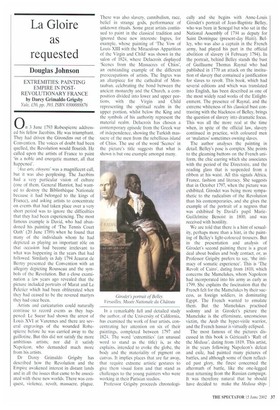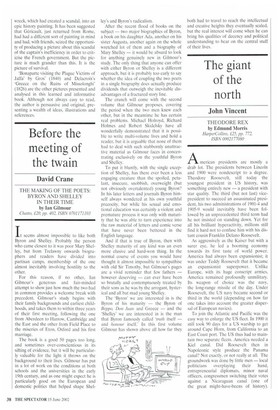requested
Douglas Johnson
EXTREMITIES: PAINTING EMPIRE IN POSTREVOLUTIONARY FRANCE by Darcy Grimaldo Grigsby Yale, £50, pp. 393, ISBN 0300088876 On 3 June 1793 Robespierre addressed his fellow Jacobins. He was triumphant. They had driven the Girondins out of the Convention. The voices of doubt had been quelled, the Revolution would flourish. He called upon the artists of France to paint 'in a noble and energetic manner, all that happened'.
'Aux arts, citoyens' was a magnificent call, but it was also perplexing. The Jacobins had a very particular vision of culture (one of them. General Hanriot, had wanted to destroy the Bibliotheque Nationale because it had belonged to the kings of France), and asking artists to concentrate on events that had taken place over a very short period was to ignore the difficulties that they had been experiencing. The most famous example is David, who had abandoned his painting of 'The Tennis Court Oath' (20 June 1789) when he found that many of the individuals whom he had depicted as playing an important role on that occasion had become irrelevant to what was happening in the years that had followed. Similarly in July 1794 Jeaurat de Bertry presented the Convention with an allegory depicting Rousseau and the symbols of the Revolution. But a close examination a few years ago revealed that the picture included portraits of Marat and Le Peletier which had been obliterated when they had ceased to be the revered martyrs they had once been.
Artists and caricaturists could naturally continue to record events as they happened: Le Sueur had shown the arrest of Louis XVI at Varennes and there are several engravings of the wounded Robespierre before he was carried away to the guillotine. But this did not satisfy the more ambitious artists; nor did it satisfy Napoleon, who demanded much more from his artists.
Dr Darcy Grimaldo Grigsby has described how the Revolution and the Empire awakened interest in distant lands and in all the issues that came to be associated with these new worlds. There was conquest, violence, revolt, massacre, plague. There was also slavery, cannibalism, race, belief in strange gods, performance of unknown rituals. Some great artists continued to paint in the classical tradition and ignored these new interests: Ingres, for example, whose painting of 'The Vow of Louis XIII with the Miraculous Apparition of the Virgin and Child' was shown in the salon of 1824, where Delacroix displayed 'Scenes from the Massacres of Chios', an outstanding example of the different preoccupations of artists. The Ingres was an altarpiece for the cathedral of Montauban, celebrating the bond between the ancient monarchy and the Church, a composition divided into lower and upper portions, with the Virgin and Child representing the spiritual realm in the upper portion, whilst below the King and the symbols of his authority represent the material realm, Delacroix has chosen a contemporary episode from the Greek war of independence, showing the Turkish massacre of the men from the rebellious island of Chios. The use of the word 'Scenes' in the picture's title suggests that what is shown is but one example amongst many.
In a remarkably full and detailed study the author, of the University of California, has examined the work of four artists, concentrating her attention on six of their paintings, completed between 1797 and 1824. The word 'extremities' (an unusual word to stand as the title) is, as she explains, intended to evoke the globe, the body and the materiality of pigment on canvas. It implies places that are far away, that require extreme artistic gestures to give them visual form and that stand as challenges to the young painters who were working in their Parisian studios.
Professor Grigsby proceeds chronologi
cally and she begins with Anne-Louis Girodet's portrait of Jean-Baptiste Belley, who was born in Senegal but who sat in the National Assembly of 1794 as deputy for Saint Domingue (present-day Haiti). Belley, who was also a captain in the French army, had played his part in the official abolition of slavery (4 February 1794). In the portrait, behind Belley stands the bust of Guillaume Thomas Raynal who had published in 1770 an attack on the institution of slavery that contained a justification for slaves to revolt. This book, which had several editions and which was translated into English, has been described as one of the most widely read works of the Enlightenment. The presence of Raynal, and the extreme whiteness of his classical bust contrasting with the blackness of Belley, brings the question of slavery into dramatic focus. This was all the more real at the time when, in spite of the official law, slavery continued in practice, with coloured men or 'mulattos' sometimes owning slaves, The author analyses the painting in detail. BeIley's pose is complex. She points to the gleaming buttons on the French uniform, the chic earring which she associates with the period of the Directoire, and the reading glass that is suspended from a ribbon at his waist. All this signals Africa, France, fashion and literacy. She suggests that in October 1797, when the picture was exhibited, Girodet was being more sympathetic to the radicalism of the Revolution than his contemporaries, and she gives the example of the portrait of a negress that was exhibited by David's pupil MarieGuillelmine Benoist in 1800, and was received with hostility.
We are told that there is a hint of sexuality, perhaps more than a hint, in the painting of Belley's light-coloured trousers. But in the presentation and analysis of Girodet's second painting there is a great deal about bodies and body contact, or, as Professor Grigsby prefers to say, 'the intimacy of somatic experience'. This is 'The Revolt of Cairo', dating from 1810, which concerns the Mamelukes, whom Napoleon had incorporated into his army as early as 1799. She explains the fascination that the French felt for the Mamelukes by their success, as foreign soldiers; in dominating Egypt. The French wanted to emulate them. But the Mamelukes practised sodomy and in Girodet's picture the Mameluke is the effeminate, unconscious victim, the Arab the hyper-virile warrior, and the French hussar is virtually eclipsed.
The most famous of the pictures discussed in this book is Gericault's 'Raft of the Medusa', dating from 1819. This artist, in the years following Napoleon's defeat and exile, had painted many pictures of battles, and although some of them reflected past glory, the finest concerned the aftermath of battle, like the one-legged man returning from the Russian campaign. It was therefore natural that he should have decided to make the Medusa ship
wreck, which had created a scandal, into an epic history painting. It has been suggested that Gericault, just returned from Rome, had had a different sort of painting in mind and had, with friends, seized the opportunity of producing a picture about this scandal of the captain's inefficiency in order to criticise the French government. But the picture is much grander than this. It is the picture of survival.
'Bonaparte visiting the Plague Victims of Jaffa' by Gros' (1840) and Delacroix's `Greece on the Ruins of Missolonghi' (1826) are the other pictures presented and analysed in this learned and informative book. Although not always easy to read, the author is persuasive and original, presenting a wealth of ideas, illustrations and references.



































































 Previous page
Previous page